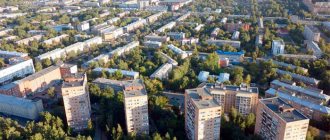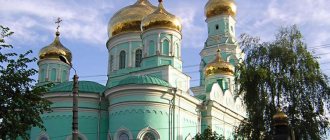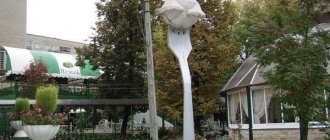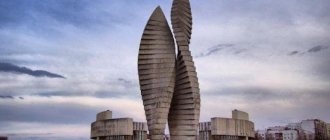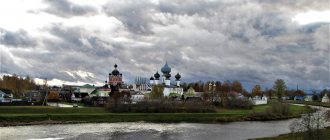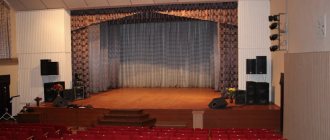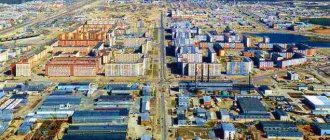Izhevsk is the recognized capital of Russian small arms. The city became famous thanks to the master inventor Mikhail Kalashnikov. The models of machines he created are considered the best in the world. Military equipment and weapons have become the hallmark of the city.
Izhevsk enterprises also produce high-quality steel, automobile and motorcycle equipment, radio components and communication systems. The city is one of the largest industrial centers in Russia. In addition, it serves as the capital of the Udmurt Republic.
Where is Izhevsk?
The city occupies a favorable position in the center of the Udmurt territory. In physical and geographical terms, its location is confined to the Volga-Kama interfluve. The settlement is located along the banks of the Izh River (a tributary of the Kama) and the Izhevsk Pond (an artificial reservoir created in the 18th century). Urban buildings occupy an area of 315.15 km².
Izhevsk has the status of an urban district and is part of the system of agglomerations of the Ural-Volga region. Its distance from other important administrative centers is:
- 295 km – to Perm (Perm region);
- 340 km - to Ufa (Republic of Bashkortostan);
- 390 km – to Kazan (Republic of Tatarstan).
Izhevsk is separated from the Russian capital by 1.13 thousand km.
The birth of Izhevsk and City Day: what has changed in 259 years
Birthday of the city of Izhevsk April 10, 1760
The documents say so - on April 10, 1760, the construction of the Izhevsk ironworks of Count Shuvalov began
Evgeny Shumilov, historian of Izhevsk, professor at Udmurt State University, Doctor of Historical Sciences
The suffix changed the city
In January 1918, the Council of Workers, Soldiers and Peasants' Deputies proclaimed the village of Izhevsky Plant a city.
We were always called Izhevsk, just sometimes the suffixes changed. Sometimes they simply called Izh, short and clear. Suffixes gradually appeared - they began to say: “I live in Izhev.” Afterwards, the purely urban suffix “sk” was added to Izhev. For the first time this can be recorded in archival documents in 1816 - Izhevsk
Evgeny Shumilov, historian of Izhevsk, professor of Udmurt State University, Doctor of Historical Sciences
In 1933, with the proclamation of the Udmurt Republic, Izhevsk became its capital
On December 27, 1984, on the initiative of the party authorities, Izhevsk was renamed Ustinov in memory of the deceased USSR Minister of Defense Dmitry Ustinov. The historical name was returned almost 3 years later. As a result of popular indignation and protest, on June 19, 1987, the city again became Izhevsk.
The city carried the new name Ustinov for 900 days
The first holiday of Izhevsk
The first City Day was held in June 1988. The celebration was modest - a small procession, a festive concert and folk festivities. However, it was then that a tradition was laid: to gather at the monument to Andrei Deryabin. This is how the holiday begins today. At the same time, the title “Honorary Citizen of Izhevsk” was established. The first to receive the title were designer Mikhail Kalashnikov, athlete Galina Kulakova and others.
An excursion into the past
31 photos
Over time, the scale of the celebration increased. We held morning exercises, master classes, sports competitions, flash mobs, fireworks and much more.
New format
Two years ago, the organizers of the holiday came up with a new format: to celebrate City Day from June 10 to 12.
REFERENCE
Since 2021, festive events have been divided into 3 blocks: on June 10, citizens celebrate Court Day, June 11 – District Day, and June 12 – the traditional City Day.
Last year, it seemed that Izhevsk residents were having fun everywhere: in every yard, square, and park. The organizers set up interactive, entertaining, and creative areas. We waited for Izhevsk residents from early morning until late evening. For young townspeople, we held our own Children's City Day with fun performances, games and art workshops.
Izhevsk celebrates City Day and Russia Day
On Courtyard Day and District Day, festivals of folk games and yard songs, demonstration performances in cheerleading and karate, a master class in boxing and modern dancing, and flash mobs were held.
What awaits us on City Day 2019?
The city authorities involved citizens in the formation of holiday programs. Now they are collecting their ideas, of which there are already more than 30.
Among them:
- photo quest around memorable places of Izhevsk;
- historical city tours on tram routes;
- exercises with a star as part of District Day;
- immersive performance (the viewer becomes a participant in the production);
- games festival;
- sailing regatta on Izhevsky Pond;
- a city garden where citizens can exchange seedlings for free.
The best ideas will be selected at the end of April and brought to life at City Day.
The festival will definitely include master classes, sports competitions, a street art festival, a festival of yard games, the “Voice of the Streets” project, and flash mobs. Many areas will also be open for children.
Artists, creative children's and adult groups of the republic will perform at the concert venues. One of the surprises will be a concert by a guest Russian pop star. Last year Stas Piekha was the headliner of the festival. It is still unknown who will come this year.
Group "Factory" - "About Love"
Traditionally, city festivities will end with fireworks. In 2018, it lasted almost 10 minutes.
Fireworks for City Day in Izhevsk
One of the innovations this year will be a change of location. The main events will be held on the pond embankment. But this is a necessary measure; renovations are underway on the Central Square.
Population of Izhevsk
From the end of the 18th century. until the beginning of the 21st century. the number of residents of Izhevsk has been steadily increasing:
- 1807 - 4 thousand people;
- 1917 – 40 thousand people;
- 1999 -655 thousand people
Period since 2000 to 2009 marked by population decline. The number of citizens during this time decreased by 44 thousand people (611.043 thousand people). Since 2010, the positive balance has been restored due to an increase in the birth rate and migration of people from rural areas. As of 2021, 648 thousand people lived in the Udmurt capital, i.e. OK. 43% of all citizens of the republic.
The city is rightfully included in the all-Russian “twenty” largest settlements.
City information
Izhevsk is the capital of the Udmurt Republic. Located between the Vyatka and Kama rivers. The economy is represented by enterprises of the metallurgical, mechanical engineering, and defense industries.
Regional roads pass through the settlement: P320, P321, P322, and the European route E22. A major highway of the Gorky Railway runs through it. There is an airport of the same name.
There are universities and their representative offices, professional and secondary specialized educational institutions. There are cultural institutions and attractions. The population is about 650 thousand people.
Sights of Izhevsk
The city is full of objects of historical and cultural value. Among them:
- 166 architectural structures;
- 81 monuments;
- 4 archaeological sites.
The Monument to the Friendship of Peoples has a special symbolic meaning, as well as the monument to Izhik, a boy gunsmith.
Exhibitions in museum complexes and exhibition halls are open to visitors:
- Udmurt National;
- Small arms named after. M. T. Kalashnikova;
- Fine Arts;
- Stories of Izhmash.
Popular message topics
- Life and work of Tyutchev
Fyodor Ivanovich Tyutchev was born on November 23, 1803 in the village of Ovstug, Oryol province. He was the second child in the family; he had an older brother, Nikolai, and a younger sister, Daria. - Tree of Life
The tree of life is a mythological symbol of most peoples. In particular, the Slavs treated the tree of life with respect, associating it with the center of the universe. - Creativity of Arkady Averchenko
A.T. Averchenko was born in Sevastopol on March 15, 1880. He was a satirist, playwright and humorist. From birth, he had health problems, namely eye disease, and this prevented him from getting
It turns out that the Russian population translated the name of the Udmurt village into Russian?
– Yes, because Udmurt names were unusual and incomprehensible to Russians. So, for example, the village of Gondyrevo bore its name until the end of the 19th century, and after that it was renamed Medvedevo . Likewise, the village of Atas became Petukhovo. This happened everywhere. It happens that Udmurt names still remain the same. The same village of Yagul, after moving to a new location, retained its old name. But the river within the boundaries of Izhevsk was most likely called Yagul, but it began to be called Podborenka. The Russian language in the factory city of Izhevsk had a dominant position and was more commonly used.
Do you think the residents of the resettled village of Yagul continued to go to the Birch Grove for prayers?
- I guess so. If this place had been the temple of the inhabitants of only one village, it is likely that information about it would not have been preserved for such a long time. After all, before Christianization, in the vicinity of each village there were more than a dozen places of cult significance. However, to this day information has been preserved only about the largest of them.
The Udmurt holidays “Gerber” and “Vyl” are held annually in the Birch Grove in Izhevsk.
You said that in the Birch Grove there was a place for prayer for the residents of the village of Karlutka?
– There is data that allows us to talk about this. Firstly, according to information from Izhevsk local historian, honorary citizen of Izhevsk A.V. Novikov , a sacred pine tree grew in this area, there was an ancient temple of the Udmurts - a place where pagan rituals were performed. It is no coincidence that this section of the city territory remained free of buildings and was used as a place for festivities. According to popular beliefs, such places were considered “unclean” and dangerous for human habitation. Secondly, the location of the Birch Grove is characterized by outstanding natural characteristics and stands out well in the area. It occupies an elevated area facing south, towards the sun, which in ancient times was covered with coniferous and deciduous trees, and a strong spring flowed at its base. It was these areas of the area that were chosen for public prayers .
Moreover, whenever possible, sacred groves were located on the opposite bank of the river and downstream from the settlement. This is exactly the location of the Birch Grove relative to the village of Russkaya Karlutka . The duplicating or clarifying name of Russian Karlutka as the Green Grove also signals to us the special sacred sound of this grove. Thirdly, it is characteristic that in the Birch Grove on the left bank of the river, near the spring, an Orthodox chapel as a sign of the Orthodox consecration of this territory, as a symbol of the fight against pagan remnants.
Udmurt activists annually hold cleanup days on the territory of the Birch Grove
Apparently, in the Birch Grove there was a large public temple ; residents from all the surrounding villages gathered there for prayers. Moreover, it was a fairly large crowd of people. After all, if at the beginning of the 18th century the villages were sparsely populated (about 30-50 adults), then by the end of the 19th century their population reached 100-150 adults. The legend about such a sanctuary has survived to this day.
The significance of this place is also determined by the fact that it is on its site that citywide Udmurt Gerber .
Flag
The flag of Izhevsk is made in the form of a rectangular panel. It is divided into two parts vertically: azure and white. Aspect ratio – 1:2. They depict elements of the city's coat of arms. Their width is 1/4 of the length of the flag, their height is 1/3 of its length.
The artistic composition was approved on April 21, 2000 and entered into the State Heraldic Register of the Russian Federation under No. 631.
Kama
It flows in the European part of Russia and is the left, largest (by length and basin area) tributary of the Volga. In the Udmurt language the name means “Big”, and in the Khanty language it means “pure”. Length – 1,805 km. The source of the Kama, originating from a basin measuring 507,000 square km, is located on the Verkhnekamsk Upland. They are fed by snow and, to a lesser extent, underground and rain. An interesting fact is that the geological age of the Kama is greater than that of the Volga. In ancient times, the Kama flowed into the Caspian Sea, and the Volga was a tributary of the Don. The situation changed after the Ice Age; now, in some scientific sources, the Kama is considered the main river, and the Volga is its tributary. Since the times of the Bulgarian kingdom it has been navigable; now in some of its sections, regular work is being done to deepen the bottom for the passage of ships. Sterlet, pike perch, perch, ide, bream, burbot, catfish and other fish are found here.
Coat of arms
The coat of arms of Izhevsk is presented in the form of a French shield. It is divided into two equal parts vertically. In a dissected silver and blue field, mites of variable colors are depicted. There is an arrow on top of them. Behind the ticks are two green rowan branches crossed. At the base there are scarlet clusters. The coat of arms reflects the past of the locality, its economy, represented by mechanical engineering and the defense sector.
Approved by decision of the City Duma No. 262 of May 27, 1997. The authors of the artistic composition are S. Bekhterev and N. Bykov. It is included in the State Heraldic Register of the Russian Federation under No. 186.
Project on the topic “My hometown is Izhevsk” for 2nd grade
Goal of the project: As part of studying the subject “The World Around You,” talk about your hometown, its attractions and memorable places.
Find information about his story and share it with your classmates. Tell schoolchildren about Izhevsk and why I love it. Prepare a report and presentation in the form of a photo story. Project plan:
- Location on the country map.
- History and symbols.
- Izhevsk in the present.
- Attractions.
- Places of military glory.
- Conclusion.
- An example of a finished photo story-presentation.
